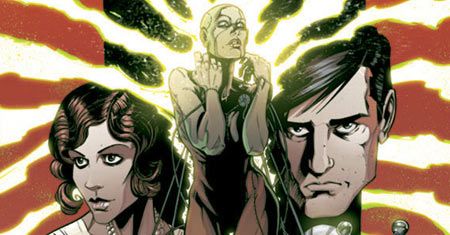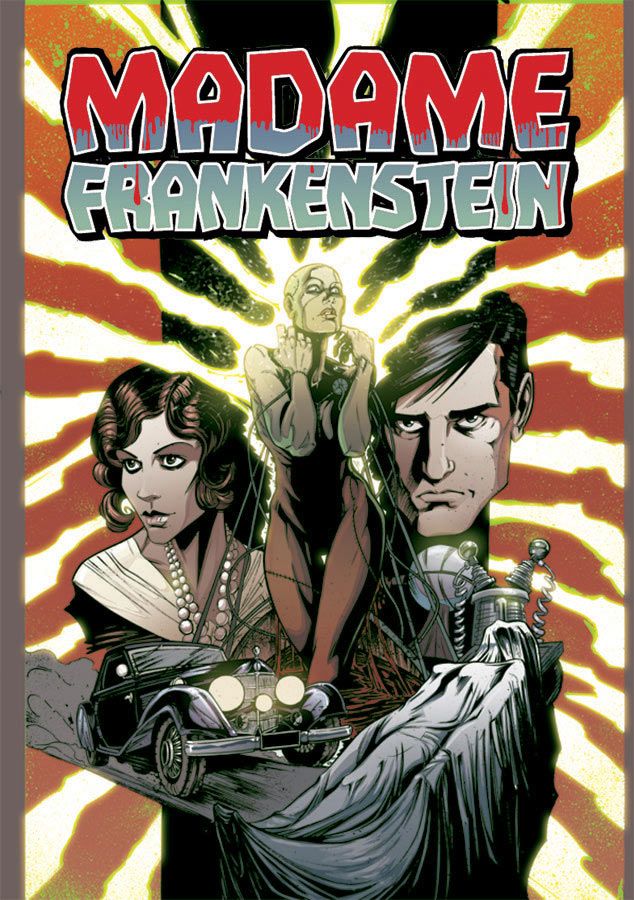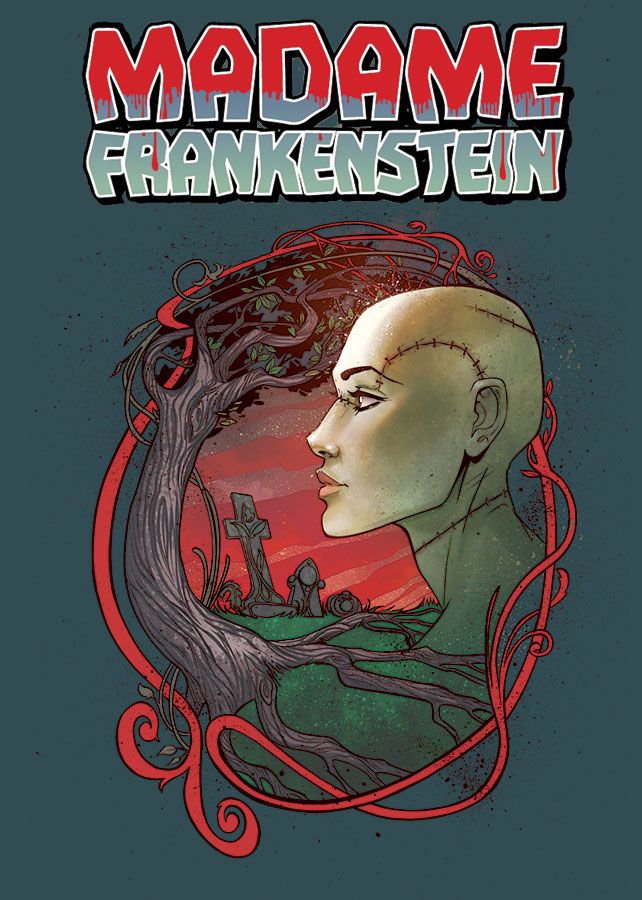Vincent Krall may have tragically lost his lover, but that doesn't mean he has to say goodbye. Instead of mourning like a proper gentleman, Krall takes a different course of action, reanimating the corpse of his departed darling -- with a few minor upgrades. Apply a jolt of electricity, some well-placed stitches and behold: "Madame Frankenstein" is alive!
Seasoned writer Jamie S. Rich and comics newcomer Megan Levens hack apart classics like Mary Shelley's "Frankenstein," the myth of Pygmalion and Galatea and "My Fair Lady," piecing them together in a stunning black and white art deco styled 7-issue miniseries from Image Comics. "Madame Frankenstein" is a horror story to be sure, but with Levens' careful use of shadow, suggestion and subtlety, it reads just like a flickering midnight movie from yesteryear -- dramatic and elegant, with atmospheric chills galore.
The pair spoke with CBR News about the series, including their shared love of Universal monster movies, how they achieved the book's unique vintage aesthetics and why Vincent should've though his decision through a bit more carefully.
CBR News: How did the two of you come to work together?
Jamie Rich:The release of this comic has a lot of gratifying synergy. I first met Megan almost exactly 10years ago when, as editor-in-chief of Oni Press, I visited the Savannah College of Art and Design for their editor's weekend. Megan was one of the graduating students, and I gave her a portfolio review. It was one of my last acts in my editorial role before moving on to go freelance. Cut ahead to 2009 and San Diego Comic Con, and we met again.
Megan Levens:For me, meeting Jamie again at San Diego Comic Con was sort of full-circle in the sense that years earlier, when he reviewed my work at SCAD, he told me I'd probably work in comics eventually. So it was a huge ego boost when we met again and he wanted to work with me as a writer, especially after seeing the caliber of artists he'd been used to collaborating with. It's interesting that as it turns out, he made his own prediction come true.
Rich: When she told me I said that with such a definitive assurance, I knew she had to be good, so there was little fear in asking to see her portfolio again. Then I really had to put my money where my mouth was and make sure I proved myself right! Really, though, the launch of this series is kind of a nice way to celebrate a complete decade of being a full-time writer. The response so far has been extremely validating for both of us.
Jamie, what was it about Megan's portfolio that stood out to you?
Rich: She had such a classic line, and I'm always drawn to clean draftsmanship, so her style immediately grabbed me. Her characters also all lived and breathed on the page, which for me is important. I tend to tell character-driven stories and I could see myself putting words in the mouths of people she was drawing.
Levens: The first thing Jamie said when I approached him and said I remembered him from my college portfolio review was, "Uh oh -- I hope I was nice to you." Fortunately, he was, both times!
I love the time era that the story is set in -- very 1930s classic Hollywood -- with so many beautiful details in the artwork. What were some of the things that inspired both of you?
Levens: Shortly before I presented the idea to Jamie, I'd revisited my old character designs for the monster -- who I'd originally drawn back in my old college sketchbooks, and never done anything with until this book -- and began dressing her in these elegant, old Hollywood gowns and art deco jewelry, sort of as a contrast to her appearance as bald and stitched-together. I liked the contrast of glamorous and gruesome, which was definitely a hallmark of the classic Universal monster films. When we started really digging into the story, keeping it in that period ended up really helping indicate who these people were and how they came to the place they are when the series opens
Rich: I'm a big fan of old movies, as well as F. Scott Fitzgerald and other early 20th Century writers, so a lot of that was in my blood already, it didn't take much arm-twisting to go along with it. Of course, I watched all of the original Frankenstein movies, some again and some for the first time, and even some of the Hammer movies, as well. There's even this really terrible 1970s Italian flick called"Lady Frankenstein"about Victor Frankenstein's oversexed daughter that I managed to sit through.
One of my favorite horror movies, and one that I tried to use as a model in how to achieve a certain mood, is Georges Franju's 1959 chiller"Eyes Without a Face." It's a gruesome character piece where a mad scientist is trying to perform a face transplant on his daughter, who was disfigured in an accident. Older films like that are really effective in terms of showing how to use suggestion instead of gore, and how characters are more important for creating an emotional stake than even the best jump scare.
I had also been reading some of the"Creepy"and"Eerie"comics through Dark Horse, both the new stuff and the reprints, because I had been pitching stories to them. Joëlle Jones and I did a short for their"Creepy"Valentine's issue last year. That proved to be a good warm-up for this.
Tell me about Madame Frankenstein -- we see her a bit in her living state, but what kind of woman is she? What was important to you when creating a character that would undergo such a massive transformation immediately into the story?
Rich: Just from a structural point of view, it didn't seem to make sense to spend three issues or however long it might take to build the back-story directly from the beginning and make people wait to see the monster. You know, it would be like launching Batman and keeping him out of the cape and cowl in favor of telling a chronological origin. There's a natural element to memory that lends itself well to storytelling. We're always remembering, all the time. Whenever we are doing other things, the brain is always examining and going over old files, so Vincent is doing the same as justification for his actions. Plus, our monster, Gail, is being re-educated about who she is and who she was, and her old personality is bubbling up through the surface. We wanted the readers to go through that process with her a little bit.
Levens: Definitely. I think the story is really about the monster's identity as Gail, which is made up of parts of who she was in her previous life, but is also a completely different person that she and the reader discover as the story develops. The series is about her coming into her own as a whole new person, beyond even what Vincent thought he was creating, and beyond what she was in her life as Courtney.
Rich: Right. We'd judge her differently if we knew everything about who she was. We'd first engage with her as this new thing with preconceived notions.
In terms of Gail's identity reasserting itself, it seems like a big part of that is the power shift that comes when you go from being controlled to becoming free. In some of the original source material you're inspired by, especially "My Fair Lady"/"Pygmalion," the protagonist decides that they want to be this perfect thing for another person, and ultimately find that this choice is rewarded. Are we going to see a more independent spirit from Gail?

Rich: Without giving too much away, I'd say the big difference is that Henry Higgins in Shaw's play is perhaps more human and not as troubled deep down as Vincent is in our book. Higgins gets more of a reward and sense of accomplishment by Eliza Doolittle taking to his lessons, even if he is a bit full of himself and a buffoon. Eliza can take his lessons and conform to a standard he expects, but she can still also be herself. Vincent has a harder time accepting that from Gail in"Madame Frankenstein." Unlike Henry and Eliza, he and the monster have a past relationship, and he thinks he's owed something. He also fails to take into account that the independent spirit that attracted him to her when she was still alive is also what got his heart broken once upon a time.
Levens: I think there's also a fear of losing her all over again, so everything Vincent teaches Gail is to maintain his control over her, at least on some level. He thinks of himself as her savior, but he also knows that she chose another man over him before, so he doesn't want her to have the independence or the power of choice to do that again. He sets some strong limits for her out of fear.
I'd like to talk a little bit about the transformation the actual source material took, turning the classic Frankenstein monster into a female. When did the aspects of "Pygmalion" enter the story?
Rich: Pretty much from the start. The core concept that Megan handed me was that our doctor was rebuilding a woman he saw as his true love, trying to make a perfect image of what he perceives womanhood to be, only to find himself growing increasingly disappointed as his creation gained sentience and became more independent. I'm a huge Audrey Hepburn fan, so I couldn't help but think of "My Fair Lady." This led to me digging up not just the George Bernard Shaw source material, his version of "Pygmalion" but also pulling out my Edith Hamilton "Mythology"book I stole from my high school back in the day and mining the myth of Pygmalion and Galatea itself for ideas. Shelley's "Frankenstein"has its origins in the Prometheus myth, so it's part of the tradition.
Levens: The monster was always female, and the creator was always male, even from my earliest sketches of the idea years ago. In my art history studies, I discovered a series of paintings by Sir Edward Coley Burne-Jones of the Pygmalion and Galatea myth, and those images stuck with me up until the final character designs. The way the sculptor was painted, he's a bit pale and gaunt, obsessive, holed up in a dark studio with the sunlight and life going on outside while he stays in, fixated on his creation. There's definitely a bit of that visual in my design for Vincent!
Rich: Thematically, our story is actually probably closer to Mary Shelley than it is James Whale and Boris Karloff. What fascinated me when I first read the"Frankenstein"novel was all the stuff about the creature being intelligent, gaining the power of speech, and challenging the notion of what it means to be human, seeing the doctor as his father, but also, like Prometheus, standing up to his supreme creator and challenging his authority. An existential notion of identity has always been part of my work, so it just seemed to make sense to me that Gail's original identity would reassert herself. We are who we are.
Tell me about Vincent -- what kind of character is he? Why is he so committed to the idea of playing God?
Rich: Like most great literary madmen, it's all hubris. What began as a noble pursuit turned into something selfish, with petty motivations. What we come to find out in "Madame Frankenstein" is that he's a man of humble beginnings who stumbled when trying to advance upward through the social classes. It's certainly a Gatsby-era idea of the American Dream, that Vincent assumes if he works hard and makes a go of it, he can be a doctor and get accepted in the ivy leagues, all of that. Only, he runs out of money, is teased for his experiments, and rejected by the woman he desires. So, his commitment shifts from "I can do this because it's something worth doing" to "I'll show you all how much smarter than you I am." And here his troubles begin --
Levens: He's a nice guy in the very worst way -- he becomes angry that the world doesn't reward him for his kindness, with the success and the money and the beautiful girl he wants. A lot of his current circumstances were certainly not his fault, but losing control over the course of his life leads him to seek control in other areas. Which kind of leads into the next question.
In the first issue, we see him manipulate his creation in several ways, both mentally and physically. Is it safe to say his revival of his lover was purely for his own motives?
Rich: Not as far as he knows, but that's kind of what makes him creepy. He thinks his intentions are noble.
Levens: He definitely thinks he's saved her, from her old life and from a man he sees as not worthy of her affections. But for me, and I hope for the reader, the sheer act of stitching her body back together with pieces of other women kind of takes him past any point of being able to come back to sanity or goodness. He definitely creeps me out. And I'm the one drawing him!
Any other projects you're working on?
Levens: Jamie and I have a graphic novel coming out next year from Oni Press called "Ares and Aphrodite" which is about as far from "Madame Frankenstein" as you can get. It's a romantic comedy set in modern day Los Angeles. There's a couple of other things very early in the works right now, and I'm sure the release of "Madame Frankenstein" bring lots of good things my way!
Rich: I've got a couple of things happening at the moment. George Kambadais and I have been creating a book for Monkeybrain called "The Double Life of Miranda Turner" that is currently available on comiXology. We're finishing up #4. It's a superhero murder mystery, of sorts. Miranda Turner had no idea that her sister was the crime fighter called the Cat until Lindy's ghost showed up to tell her she'd been killed, enlisting Miranda to find the culprit.
I also have an Oni Press graphic novel called"Archer Coe and the Thousand Natural Shocks," which is due in stores onJune 18. Dan Christensen is drawing that. It's a crime story about a hypnotist wrapped up in a serial killer mystery that may have some ties to his past. It's kind of a weird melding of old pulp detective stories and more abstractsupernatural stories. I'm really excited for people to read it.
If you were going to recreate another classic monster story, what would it be?
Rich: I've always been partial to Dracula, but I would have no idea to make something new out of it. I gravitate more to ghost stories, honestly. I love stuff like the original"The Haunting," where the scares are more psychological, more about atmosphere. Nicolas Hitori de and I have actually been developing something more along the lines of ghosts and demonic possession, something more like"Rosemary's Baby"and"Suspiria."
Though, now that I think of it, I wouldn't mind playing around with the original"Cat People," the Val Lewton-production. That seems up my alley.
Levens: "Dracula" would be my first choice, too, but I think it's just me selfishly wanting to play in that world, not really having something new to bring to it. Maybe the Mummy? I used to be obsessed with ancient Egypt so that'd be fun to draw. Or "Phantom of the Opera." Both of those have had pretty cheesy resurrections and I'd love to go someplace darker with them.




